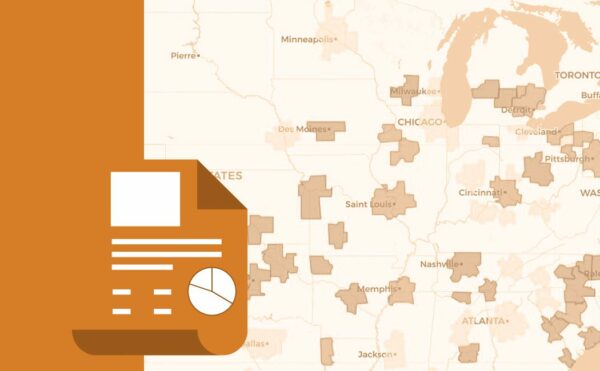
March 19, 2024
Originally published via UrbanLand
Real estate economists predict solid performance by U.S. property markets over the next three years, according to the spring 2022 ULI Real Estate Economic Forecast. This is in spite of predictions of rising inflation and slower economic growth as a result of the Russia/Ukraine war and other developments.
While the real estate–related components of the forecast are generally positive, contributing economists downgraded near-term economic growth and predicted significantly higher inflation and interest rates during the forecast period (2022–2024) compared with the prior fall forecast. At the same time, respondents raised forecasts of real estate transaction volumes, unleveraged returns, and rental growth for most property types.
In many ways, 2021 was a remarkable year for many economic and real estate indicators, as the United States recovered from the pandemic-related downturn, aided by stimulus spending and near-zero interest rates. Some of the metrics for that year that posted results that were both well above average and ahead of expectations, include gross domestic product (GDP) growth (5.7 percent), employment growth (6.7 million), real estate transaction volumes ($846 billion), real estate investment trust (REIT) returns (43.2 percent), and NCREIF Property Index returns (17.7 percent).
While these outsized results provide strong momentum in 2022, some pullback from record levels is also to be expected.
The relatively positive findings and predictions in the Spring Survey point to some fundamental attributes of real estate that dampen volatility. Most property types have multiyear leases and cater to local rather than to global demand drivers, both of which insulate the sector from economic volatility and foreign turbulence.
The Real Estate Economic Forecast, produced by the ULI Center for Real Estate Economics and Capital Markets, is based on a survey conducted in March and April of 2022 of 47 economists and analysts at 36 leading real estate organizations. The forecast is based on the median responses gathered in the survey, which reflect a wide range of views both better and worse.
Key Findings for Commercial Real Estate
U.S. real estate transaction volumes are predicted to decline slightly to $800 billion in 2022, after a record high $845 billion in 2021. Still, transactions will stay well above the long-term average ($427 billion), with forecasts of $725 billion and $750 billion in 2023 and 2024, respectively. Commercial mortgage–backed securities (CMBS)debt availability will remain steady, with the projected issuance of $90 billion to $100 billion of CMBS in 2022–2024, down slightly from $111 billion in year 2021 but above the long-term average of $83 billion.
Commercial real estate prices, as measured by the Real Capital Analytics (RCA) Commercial Property Price Index, are projected to rise by 10.0 percent in 2022, higher than had been projected in the fall, 6.0 percent in 2023, and 5.9 percent in 2024. The index surprised on the upside in 2021, rising by 19.5 percent.
The forecast total return from unleveraged core real estate (NCREIF Property Index or NPI) is 10.0 percent in2022, up from the 7.0 percent predicted six months ago. Like the CPPI, 2021 returns greatly exceeded expectations, with a total return of 17.7 percent. Total returns are projected to be 8.0 percent in 2023, also up from the prior forecast, and 7.0 percent in 2024.
Returns will vary widely by property type. Average returns over the three-year forecast period will range from 13.9 percent for industrial to 5.4 percent for office, with apartments at 10.3 percent and retail at 5.9 percent. The forecast 20.0 percent return for industrial in 2022 is down from 43.3 percent in 2021, a record for an individual property type and a big driver of overall NPI returns. Forecast returns for equity REITs are 8.0 percent in 2022 and8.3 percent in 2023, both lower than the prior forecast as well as the long-term average of 12.7 percent. Modest expectations for equity REITs are understandable given the index’s high return of 43.2 percent in 2021 (compared with 27.8 percent forecast last fall).
As the ULI/PwC Emerging Trends in Real Estate and other publications have noted, the pandemic accelerated many trends that were previously underway. Two of the most prominent trends in U.S. real estate have been heightened demand for industrial space and apartments. The industrial/warehouse sector finished 2021 with an availability rate of 5.2 percent, down from 6.2 percent in 2019 (pre-COVID) and 440 basis points lower than the long-term average of 9.6 percent. Consequently, industrial/warehouse rent growth is forecast to average 5.5percent over the next three years, compared with the 20-year average of 1.8 percent. Prospects for the apartment sector are similar. The forecast 2022 vacancy rate of 2.5 percent is 160 basis points lower than in 2019 and less than half of the long-term average (5.2 percent). Apartment rent growth is forecast to average 5.3 percent over the 2022–2024 period. For both of these property types, availability or vacancy rates are expected to increase slightly over the forecast period but remain well below long-term averages.
More Urbanland ULI Forecasts
The availability rate forecast for neighborhood and community centers is 7.9 percent each year from 2022 to2024, lower than the 2019 rate of 8.5 percent. The office sector will lag behind the other main property types as the pandemic has slowed office re-openings and companies experiment with hybrid strategies. Office vacancy rates will peak at 17.0 percent in 2022 and 2023, before dropping slightly in 2024. The predicted office vacancy rate will exceed its long-term average (14.5 percent) over the entire forecast period. Expected rental growth is modest for retail and office, with three-year rent growth averaging 2.0 percent and 1.4 percent, respectively.
The hotel sector continues to lag pre-pandemic occupancy levels as business and international travel slowly recovers. The national occupancy rate is expected to be 60.0 percent by the end of 2022, climbing to 62.6 percent in 2024. The latter rate is above the long-term average of 60.9 percent but lower than the 2019 level of 65.9percent. On the positive side, hotel revenue per available room (RevPAR) will average 11.5 percent growth over the next three years, well above the long-term average of 3.5 percent.
The outlook for the single-family-housing sector remains positive, although recent increases in mortgage rates may slow the sector. Economists are forecasting 1.2 million new housing starts in 2022, with 1.25 million new starts in 2023 and 1.1 million in 2024, above the 20-year average of 935,000. Average home prices will increase by 10.0 percent in 2022, then decelerate to closer to the longer-term average of 4.6 percent, with 5.0 percent in2023, and 4.4 percent in 2024. Average home prices rose by 17.6 percent in 2021, much higher than 10.9 percent predicted last fall.
Key Findings for Major Economic Indicators
The U.S. GDP is projected to grow by 3.2 percent in 2022, down from 4.0 percent forecast six months ago, as labor shortages, likely slower global growth, and continued supply chain constraints affect U.S. prospects. Continued GDP growth is expected in 2023 and 2024, with forecast increases of 2.3 percent and 2.1 percent, respectively, similar to the long-term average of 1.95 percent.
Economists predict that the economy will generate 4.1 million net new jobs during 2022, which, combined with again of 6.7 million in 2021, will make up for and exceed the 9.3 million jobs lost in 2020. Job growth will slow in2023 and 2024, with increases of 1.9 million and 1.2 million, respectively, both above the long-term average of 1.0 million.
The forecast calls for the U.S. unemployment rate to end 2022 at 3.5 percent, down from 4.0 percent predicted six months ago and from 3.9 percent in 2021. The unemployment rate is predicted to stay fl at at 3.5 percent in2023 and 3.6 percent at year-end 2024, below the long-term average of 5.9 percent, and equal to the pre-pandemic 2019 level of 3.6 percent.
As discussed above, expectations for inflation have risen over the past six months, as the Russia/Ukraine war has added to both inflation and supply chain issues. Economists forecast that the Consumer Price Index (CPI)will rise by 6.0 percent in 2022, up from 3.0 percent predicted six months ago. Last year’s rise of 7.0 percent was the highest annual rate of increase since 1990. The CPI is expected to rise by 3.0 percent in 2023 and 2.5 percent in 2024, above the 20-year average of 2.4 percent, but a sizable drop from current levels, indicating that survey respondents believe that current inflationary pressures are mostly short-term in nature.
Expectations for long-term interest rates have reversed direction over the past six months. Responding economists raised the expected rate of the 10-year U.S. Treasury (UST) note to 2.7 percent by year-end 2022from 2.0 percent predicted six months ago. Rates will rise to 3.0 percent in both 2023 and 2024, close to the long-term rate of 2.9 percent.
The ULI spring survey is predicting slower near-term growth and higher long-term interest rates compared with the prior forecast. The impact of the Russia/Ukraine conflict has contributed to inflationary pressures and reduced growth expectations, but more importantly adds greater uncertainty. As the Federal Reserve recently noted, the economic outlook is “clouded by the uncertainty created by recent geopolitical developments and rising prices.” Despite this uncertainty, real estate economists are predicting that U.S. real estate markets are generally in strong shape and are likely to perform well in terms of fundamentals, capital flows, and investment returns over the next several years.
Disclaimer: Reasonable efforts have been made to ensure that the data contained in this Advisory reflect accurate and timely information, and the data is believed to be reliable and comprehensive. The Advisory is based on estimates, assumptions, and other information developed by RCLCO from its independent research effort and general knowledge of the industry. This Advisory contains opinions that represent our view of reasonable expectations at this particular time, but our opinions are not offered as predictions or assurances that particular events will occur.










